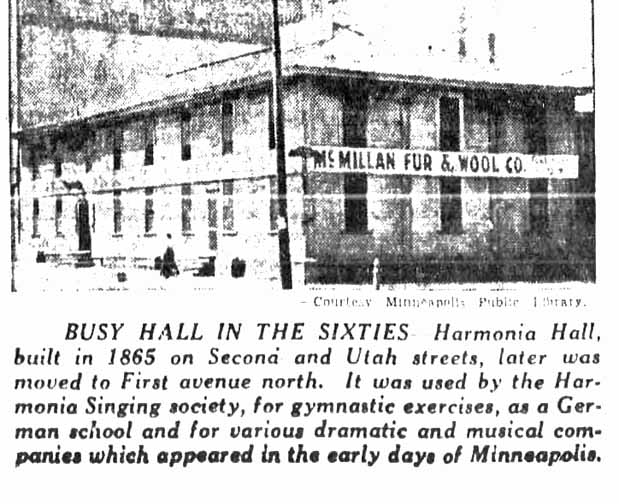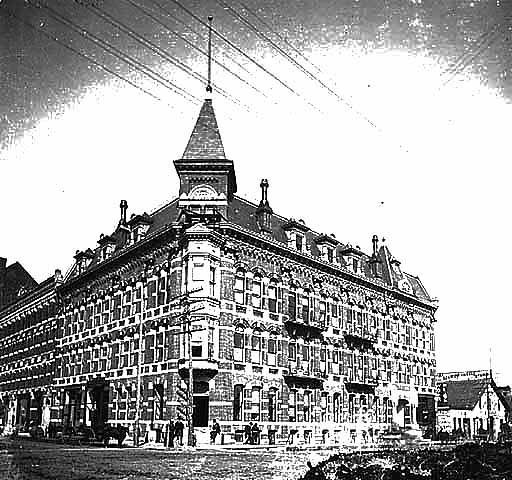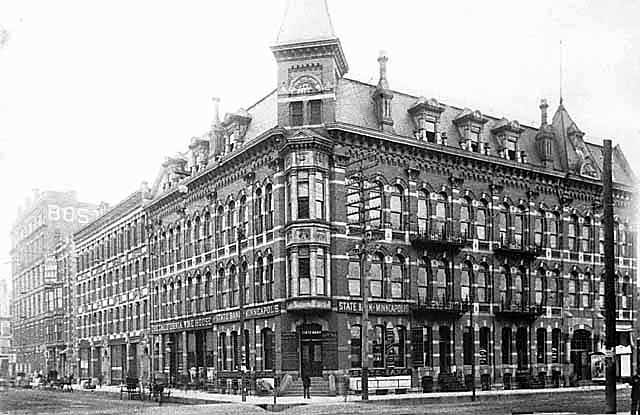Harmonia Hall
Minneapolis
According to an early history of Minneapolis theaters, Harmonia Hall was our second theater, “and the one that better suited the ideas of the Minneapolis theater-going public” than Woodman’s Hall. (Minneapolis Tribune, January 1, 1882)
HARMONIA HALL I
The first Harmonia Hall was built in 1859 at Second Avenue North and Second Street. It was built by the Harmonia Singing Society, an organization founded in the early 1860s by members of Minneapolis’ German community.
“Harmonia Hall boasted a proscenium, a decided advance among these temples of Thespis, and this proscenium is still standing – a bizarre anachronism in a remodeled building now used for the storage of hides. Generations of strolling players, forgotten plays, the genesis of the present symphony orchestra, amateur players forgetting their lines, the Swiss Bell Ringers, Fay Templeton, stereopticon lectures, ‘Buffalo Gals’ sung in a blackface act – the proscenium with diamond-shaped panels set at decorative intervals has seen them all.” (Edgar)

In 1868 the building was redecorated with life size paintings and ornamental scroll work on the ceiling.
The building served several purposes:
- It was used by the Harmonia Singing Society
- Gymnastic exercises
- A German school house
- Various dramatic and musical companies who appeared from time to time. (Minneapolis Tribune, January 27, 1935)
Edgar wrote:
Rival theaters crowded into the neighborhood of the Harmonia and these in turn disappeared. Finally the Harmonia was closed and its name transferred to a new place of amusement. The seats were removed, the stage pulled down, and all things that had borne the semblance of a theater, with the exception of the proscenium, ceased to exist.
By 1882 the building was a place for storing and bargaining in hides and pelts.
Before 1935 the building was moved to 200 First Avenue North.
HARMONIA HALL II
In 1884, the Harmonia Society, now over 200 members strong, built a new Harmonia Hall. The City’s official address is for this building was 200-218 Third Street South (at the northeast corner of Second Avenue South and Third Street – Minneapolis Music Report).
The permit card shows the original footprint to be 88 x 120 x 66 (4 stories), to be built at a cost of $500,000. The wrecking permit shows two buildings: one with the dimensions above, wrecked in December 1961, and another with the dimensions of 66 x 120 x 38 (3 stories), wrecked in October 1962.
Its Norwegian-born architect, Carl Struck, was the same architect who designed Dania Hall. Activities were to include concerts, operas, plays, and other events.
Architecture critic and author Larry Millett describes the building:
The building had reddish brick walls threaded with bands of white Ohio sandstone. There were long rows of pointed-arch windows on the upper floors. The mansarded attic was full of dormers and pinnacles. An angled corner tower rose above bay windows.
The horseshoe-shaped auditorium took up the second and third floors. The stage was on the Second Ave. side, while the amphitheater extended eastward. The original auditorium seated about 1,000 people. Later, the balcony would be made into a third floor.
GRAND OPENING
The Grand Opening was held on December 13, 1884. The proceedings featured a concert by the Frank Danz Orchestra and other musical numbers. There was “a neat little play,” and a speech (in German) about the early days of the Harmonia Society. After a feast there was music and dancing. (Minneapolis Tribune, December 14, 1884)
German, Scandinavian, Irish, and other organizations used the hall for a variety of events.
Permit cards show other early activities in the building:
- A bowling alley
- Saloon (as early as 1893)
- Printing shop
- Factory
- Pool Room
- Private Garage
This was a huge building, so there were a lot of addresses associated with it, some on Third Street and some on Second Ave.


DEPRESSION
The Crash of 1893 affected about everyone, and the Harmonia Society was no exception. They were forced to default on the hall’s mortgage, although the hall itself stayed open.
In 1899 it was announced that the hall would be transformed into the New Harmonia Theater, a beautiful amusement auditorium. It would host vaudeville acts and have a house orchestra that was familiar with the “catchy music” of the day. (Minneapolis Tribune, April 30, 1899) The last notice for the theater in the paper was in January 1900, however, and it appears that the building reverted to the name Harmonia Hall.
The first indication that the building was being converted to a hotel from the permit cards was in July 1903. A note in the Minneapolis Journal said that J. Schutt and Sons were making $13,000 in improvements in the building and were contemplating more. (June 13, 1903) Unfortunately, a plasterer was killed that July during that renovation. The stage was torn out and the balcony was turned into a third floor. The building became commercial property and quickly filled up “from cellar to garret.” (
Boxing took place at the Hall in 1903 – apparently without the proper permission. Other uses were “low class dances” and wrestling matches.
On January 28, 1905, fire destroyed the upper floors of the hall, including the auditorium and the attic. Six people, including a couple with a baby, managed to escape, with the baby being dropped 23 feet from a fire escape into the arms of a waiting fire fighter. The permit card estimated the cost to repair at $7,500. News reports say that the building was owned by the John Noble Estate and that the building, described as dilapidated, was insured. Damage was estimated at $150,000. Ten businesses were affected, including William Dunn’s Saloon. This story was told in magnificently flowery language in the Minneapolis Tribune, January 29, 1905.
THE COLLEGE BLOCK
The building was rebuilt after the fire, but without its attic and tower. Architect Glenn L. Saxton designed the third floor for the Caton Business College, and on January 1, 1906, the building became known as the College Block. A new front entrance was constructed on the Second Ave. side, and ads show that the college’s address was 253 Second Ave. So. But they also show that the name didn’t make it out of 1906.
REX HOTEL
The first ads for the Rex Hotel are from May 1907. The Rex was in Skid Row, and for men only. On August 29, 1907:
Traveling men are invited to inspect the new Rex Hotel. Superbly furnished. Newest in the City. (Minneapolis Tribune)
Ads offered private dining rooms on the second floor, serving the choices delicacies of the season, catering to after-theater parties. It wasn’t long before a waiter was caught serving liquor to someone in one of those private dining rooms, way after closing time. $35 fine.
This is confusing. There were two buildings. In 1909 there is an article about building or renovating the Rex to provide a place for transients. This is the Rex for men only that we think of on Skid Row.


